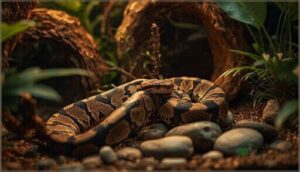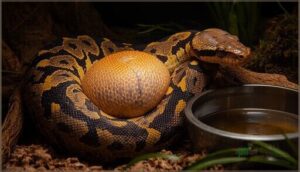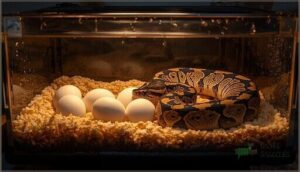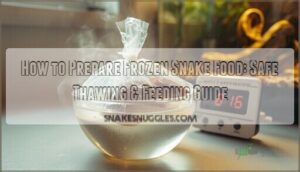This site is supported by our readers. We may earn a commission, at no cost to you, if you purchase through links.
Your first ball python clutch doesn’t have to feel like a gamble. Every year, breeders watch their carefully planned pairings fail because they missed a subtle temperature shift during cycling or paired a female who looked ready but wasn’t quite there yet.
The difference between a healthy clutch of eight eggs and a season of disappointment often comes down to a handful of specific decisions—most of which happen weeks before your snakes ever meet.
Getting ball python reproduction tips right means understanding what triggers breeding behavior, recognizing the physical signs that separate “maybe ready” from “definitely ready,” and creating conditions that let nature do what it does best without you accidentally getting in the way.
Table Of Contents
- Key Takeaways
- Preparing Ball Pythons for Breeding
- Determining Breeding Readiness
- Pairing and Breeding Process
- Identifying Ovulation and Egg Laying
- Egg Incubation and Hatchling Care
- Frequently Asked Questions (FAQs)
- How do you breed ball pythons for beginners?
- How long do you leave ball pythons together when breeding?
- Can I let my ball python incubate her own eggs?
- How to tell if a female ball python is ready to breed?
- How to handle aggressive behavior during breeding?
- What are signs of stress in breeding snakes?
- Can diet impact breeding success in ball pythons?
- How to prevent injuries during mating attempts?
- What to do if breeding attempts fail?
- What diet changes help breeding ball pythons?
- Conclusion
Key Takeaways
- Successful ball python breeding depends on precise temperature cycling (dropping to 72–75°F over 2–3 months) and lighting adjustments starting in October, which triggers follicle development in up to 85% of females and synchronizes breeding season.
- Females need to hit at least 1,500 grams (ideally 1,800–2,000 grams) and be 27–31 months old before breeding, while males are ready around 700–800 grams at 16–18 months—rushing these benchmarks increases risks like egg binding.
- Watch for the dramatic ovulation swelling in the last third of the female’s body, followed by a pre-lay shed 2–3 weeks later, which gives you the countdown to set up a proper egg-laying box with 99–100% humidity.
- Egg incubation requires rock-solid temperature control at 89–90°F and 90–100% humidity for roughly 50–55 days, with daily monitoring to prevent mold and temperature spikes that can wreck your entire clutch.
Preparing Ball Pythons for Breeding
Getting your ball pythons ready to breed isn’t something you just jump into—it takes some thoughtful planning and environmental tweaking. You’ll need to mimic the seasonal changes these snakes experience in the wild, which means adjusting temperatures, lighting, and even giving them a cooling period.
Let’s walk through the key steps to get your breeding setup dialed in properly.
Seasonal Temperature and Lighting Adjustments
When October rolls around, you’ll want to start tweaking temperatures and lighting to signal breeding season.
Drop your nighttime temperature to 82°F on the hot spot and 78°F on the cool end—this seasonal simulation mimics their natural African environment. Switch your lighting schedule to 14 hours dark and 10 hours light, using natural sunlight spectrum bulbs.
To further stimulate breeding, consider breeding room preparation. Temperature monitoring with digital thermostats keeps everything stable and stress-free.
Cooling Periods and Cycling Techniques
Beyond basic temperature drops, cycling your ball pythons means gradually reducing the cool spot to 72–75°F over 2–3 months. This controlled cooling stimulates follicle development in up to 85% of females and helps synchronize your breeding season—most breeders cycle between October and December.
You’ll notice appetite changes as breeding cycle readiness kicks in, with follicles reaching that critical 5mm threshold. Proper cycling reduces quiescence incidence by 10–12%, maximizing breeding success. Females should ideally be over 1,500 grams to guarantee safe breeding, with body weight crucial.
Health Checks and Body Condition Assessment
Before you start pairing, you’ll want to confirm your ball pythons are actually healthy enough to breed. Annual vet visits catch problems early—think fecal tests for parasites and physical exams for body condition scoring.
Here’s what to monitor:
- Weight Assessment: Female ball pythons need at least 1,500 grams before breeding; track weekly to spot concerning drops.
- Health Screening: Test for nidovirus and parasites (found in 11–23% of collections).
- Reproductive Monitoring: Use ultrasound to check follicle development in your gravid female, catching egg retention issues 92% of the time.
Disease challenges like egg-binding affect 7–12% of breeding females, so don’t skip these checks.
Determining Breeding Readiness
Before you pair your ball pythons, you need to make sure they’re actually ready for the job. This isn’t just about throwing two snakes together and hoping for the best—there are real age, weight, and compatibility factors that determine success.
Let’s break down what makes a ball python breeding-ready so you don’t waste time or risk the health of your animals.
Female Maturity, Weight, and Age Requirements
You’ll want your female ball python to weigh at least 1500 grams before breeding—though waiting until she’s closer to 1800–2000 grams gives you better odds. Age matters too, but it’s really about body condition. Most females hit their stride between 27 and 31 months. Here’s what you need to watch:
| Factor | Recommended Standard |
|---|---|
| Minimum Weight | 1500 grams (ideally 1800–2000g) |
| Age at Maturity | 27–31 months typical |
| Health Screening | Ultrasound for follicle development |
| Body Condition | Healthy girth, not just weight |
| Reproductive Lifespan | Viable for 20+ years with care |
Don’t rush it—breeding female ball pythons too early increases risks like egg binding. A healthy female ball python with good follicles and proper weight will reward your patience with consistent clutches for decades.
Patience pays off—breeding females too early risks egg binding, while proper weight and health deliver decades of successful clutches
Male Maturity, Weight, and Breeding Potential
Males are ready when they hit 700–800 grams—usually between 16 and 18 months. Look for sperm plug indicators as a solid sign of maturity.
Breeding male ball pythons at prime breeding weight ensures better fertility longevity and lets one male cover 4–6 females per season without losing steam.
Environmental stress or obesity kills their drive, so keep conditions stable and body condition ideal.
Selecting Compatible Breeding Pairs
Morph compatibility matters—crossing incompatible lines like different albinos gives you 100% normal-looking babies carrying both genes. Health screening catches respiratory issues lurking in up to 19% of ball pythons before breeding.
Track genetic lineage to boost clutch success by 17%. Watch behavioral cues during introductions—12–15% of pairings fail from personality clashes despite meeting age thresholds.
Unrelated males and females reduce birth defects by 18%.
Pairing and Breeding Process
Once you’ve got your snakes ready and paired up, the actual breeding process becomes a waiting game mixed with careful observation. You’ll introduce the male to the female’s enclosure and watch for specific behaviors that signal things are moving in the right direction.
Understanding what’s normal during courtship and mating helps you know when to step back and let nature do its thing.
Introducing Males to Females
After a month of temperature and lighting adjustments, you’re ready to introduce males to females—usually in November when those seasonal cues peak.
Environmental preparation matters: keep enclosures quiet, maintain your cycling temps, and pair them for 2-3 days. Male rotation between females can boost copulation rates by up to 38%.
Monitoring pairings daily helps you catch locks and reduces pairing stress through careful introduction timing.
Recognizing Courtship and Copulation Behavior
Recognizing courtship display behaviors ensures you don’t miss successful breeding windows. When males wrap tightly around females and align their cloacas, you’re watching nature’s choreography unfold.
Key courtship and copulation signals include:
- Males rubbing their chin on females to trigger receptivity
- Females lifting and coiling their tails near the cloacal area
- Locking behavior lasting 1-4 hours, sometimes repeated multiple times
- Increased male activity and restlessness during breeding season
Female receptiveness shows through reduced aggression and active mate-seeking.
Monitoring Breeding Attempts and Locks
You’ll want to track every lock with digital record-keeping tools like Reptile Logger—data-driven breeding separates pros from hobbyists.
When you pair for 4-5 days instead of just overnight, lock success rates jump from 60-80% to nearly 100%.
Experienced breeders use ultrasound monitoring and statistical analysis to confirm breeding success, making ball python behavior tracking essential for optimizing your breeding process and clutch outcomes.
Identifying Ovulation and Egg Laying
Once your female has been bred, the waiting game begins—and trust me, it’s one of the most exciting parts of ball python breeding. Spotting the signs of ovulation and understanding what comes next can mean the difference between a successful clutch and a stressful guessing game.
Let’s walk through what to watch for, how to set up for egg laying, and what your girl needs during this critical time.
Behavioral and Physical Signs of Ovulation
You’ll know ovulation is happening when your female ball python starts showing some pretty unmistakable signs. Palpating follicles beforehand helps, but the real show is during ovulation itself—that dramatic swelling in the last third of her body looks like she swallowed a football.
Here’s what to watch for:
- Ovulation swelling peaks around 12-24 hours, creating that distinctive lumpy, enlarged belly
- Glowing appearance when she’s coiled, signaling breeding readiness
- Defensive coiling with increased restlessness or wrapping around water bowls
Females often fast for weeks leading up to this moment, then become noticeably protective. After ovulation passes, you’ll see a pre-lay shed roughly 2-3 weeks later—your countdown to egg-laying begins.
Providing Proper Egg Deposition Sites
Once ovulation passes, your female needs a secure egg-laying box ready to go. Use vermiculite or Hatchrite as substrate—keeping it moist but not soaking wet creates that 99-100% humidity eggs need. A simple 14″ x 8″ x 5″ box works great.
Monitor temperature gradients carefully, staying around 88-90°F. Opaque boxes boost her comfort, which directly impacts clutch size and egg health.
Recognizing and Managing Pre-Laying Behaviors
After setting up her nesting box, watch for key pre-lay signals. About 16 days before egg laying, she’ll go through a prelay shed—look for that telltale blue phase.
Then expect increased restlessness, weaving around the enclosure, and tight coiling postures (sometimes even upside-down). Her follicles will reach 40mm diameter, and you’ll notice distinct body firmness.
Catching these signs helps prevent complications like becoming egg bound.
Egg Incubation and Hatchling Care
Once your female lays her eggs, the real waiting game begins. Getting the incubation setup right makes all the difference between healthy hatchlings and disappointment.
Let’s walk through the key steps to keep those eggs safe and give your baby ball pythons the best start possible.
Incubation Temperature and Humidity Control
Getting reptile egg incubation right comes down to nailing temperature regulation and humidity control in your incubator. Here’s what keeps your clutch safe and boosts hatch rate:
- Keep temps steady at 89°F–90°F for Temperature Stability and Defect Prevention
- Maintain 90–100% humidity using Humidity Monitoring with a reliable hygrometer
- Use water trays for smooth humidity control
- Check daily for Mold Prevention
- Avoid spikes above 91°F
Monitoring Egg Development and Viability
Once your eggs are incubating, you’ll want to track egg development stages using Egg Candling—shine a light through the shell every few days to spot blood vessels and embryo movement. Ultrasound Monitoring takes it further, measuring follicles and detecting heartbeats.
Check Viability Factors like color, firmness, and smell. Healthy eggs mean better Hatching Success, while spotting Mortality Causes early—mold, collapse, foul odor—protects the rest of your clutch.
Caring for Hatchlings After Hatching
Right after hatching, your baby snakes need Enclosure Setup with secure locks, 88-90°F basking spots, and 70-85% humidity on the cool side—essential for Shedding Management.
Wait 7–10 days post-hatch for Initial Feeding with appropriately sized hopper mice.
Health Monitoring through daily checks and Handling Techniques (support their whole body!) keeps stress low.
Proper Hatchling snake care means over 95% survival in those key first months.
Frequently Asked Questions (FAQs)
How do you breed ball pythons for beginners?
Start with healthy adults—females around 1200 grams, males 700+ grams. Cycle temperatures, introduce pairs in fall, watch for locks, then monitor ovulation signs.
Incubate eggs at 88-92°F for roughly 50-55 days.
How long do you leave ball pythons together when breeding?
When breeding ball pythons, most breeders pair them for just 2-3 days—or until you spot that telltale copulation “lock.” Timing’s everything: watch for the weaving dance, then give both snakes well-earned rest periods afterward.
Can I let my ball python incubate her own eggs?
Yes, your ball python can incubate her own eggs if she’s over 1800 grams and healthy.
Maternal incubation pros include natural hatchling vigor, though incubation challenges exist. Keep a backup incubator ready for safety.
How to tell if a female ball python is ready to breed?
Your female is ready when she reaches a minimum weight of 1,500 grams and has experienced her third winter. Look for behavioral indicators such as the glow, follicle palpation revealing development, and a solid health status confirming she can handle breeding safely.
How to handle aggressive behavior during breeding?
Pairing aggression risks pop up, but you can prevent problems. Separate snakes showing striking or thrashing immediately—males often get bitten.
Monitor breeding encounters closely, watching for snake behavior cues that signal stress.
What are signs of stress in breeding snakes?
Watch for escape attempts, defensive balling up, refusal to eat, or head hiding—behavioral changes signaling hormonal imbalance.
Poor husbandry triggers stress during the ball python breeding process, directly impacting clutch success and snake breeding outcomes.
Can diet impact breeding success in ball pythons?
Think of nutrition as the foundation your breeding program stands on—without proper diet and fertility management, even perfect temperatures won’t deliver results.
Feeding frequency impact, prey nutritional value, and conditioning diet effects directly influence egg fertility and hatchling health in the ball python breeding process.
How to prevent injuries during mating attempts?
You’ll prevent breeding injuries through proper health checks before pairing, controlling enclosure conditions, supervising initial introductions, and watching for aggression.
Monitor males for cloacal swelling post-lock and separate pairs promptly after copulation.
What to do if breeding attempts fail?
Nearly half of ball python breeding ventures fail within five years. When breeding attempts don’t work, try ultrasound monitoring to time pairing, adjust environmental conditions, isolate incompatible pairs, provide veterinary intervention for health problems, and improve nutritional support for your snakes.
What diet changes help breeding ball pythons?
You’ll want to bump feeding frequency to every 7–10 days for females before breeding, helping them hit that 1,500-gram sweet spot. Males often fast during pairing—totally normal.
Monitor weight closely, and consider monthly prey supplementation with calcium powder for breeding females building follicles.
Hydration matters too, especially pre-laying.
Conclusion
The right pairing doesn’t guarantee success, but the wrong preparation guarantees failure. The proper cooling doesn’t create magic, but skipping it creates frustration.
These ball python reproduction tips aren’t shortcuts—they’re the difference between watching your female refuse to ovulate and holding healthy hatchlings three months later.
Your snakes already know how to breed. Your job is simply to stop interfering with what millions of years already figured out.
- https://talis-us.com/blogs/news/optimal-temperature-ranges-for-ball-pythons
- https://www.sciencedirect.com/science/article/abs/pii/S0306456502000487
- https://reptifiles.com/ball-python-care-guide/ball-python-humidity-temperatures/
- https://ballpython.ca/breeding/
- https://www.zenhabitats.com/blogs/reptile-care-sheets-resources/ball-python-complete-lighting-and-heating-guide














